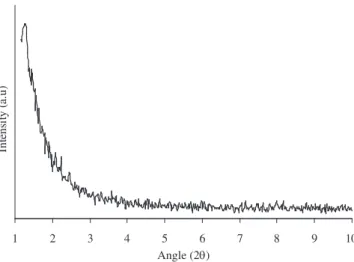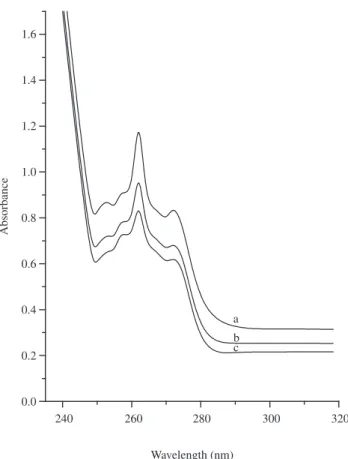Materials Research, Vol. 11, No. 4, 443-446, 2008 © 2008
*e-mail: venkatathrin@yahoo.com
Synthesis of Mesoporous Silica Microsphere from Dual Surfactant
Venkatathri Narayanan*
Department of Chemistry, National Institute of Technology,
Warangal 506 004, Andhra Pradesh, India
Received: June 9, 2008; Revised December 10, 2008
A new procedure is reported to synthesis mesoporous silica micro sphere for the first time. In these method two surfactants namely Span 80 and Tween 80 were used. Small angle X ray diffraction and N2 adsorption analysis shows the synthesized material has mesoporous property. The material has spherical morphology with 1-10 µm particle size. Beside the material found to have microcapsule property as observed from the Transmission electron microscopy. The Fourier transform Infrared spectroscopic analysis reveals that the materials are similar to other mesoporous materials. We also encapsulated an UV-absorber Ibuprofen inside the microcapsule, by mixing it before the synthesis. This shows a possibility of the materials in cosmetic applications.
Keywords: mesoporous silica micro sphere, Tween 80, Span 80
1. Introduction
Since silica based mesoporous molecular sieves using surfactant assemblies as supramolecular templates were reported in 19921,2,
mes-oporous materials have opened many new possibilities for application in catalysis3, separation4, and nanoscience due to their tunable pore
sizes and very large surface areas5-7. More recently, mesoporous silica
with morphologies including thin films, monoliths, hexagonal prisms, toroids, discoids, spirals, dodecahedron and hollow tubular shapes have been synthesized8-12. In conventional procedures, silica spheres
have been obtained using surfactants, block copolymers and recently by using colloidal suspensions13. Normally polymers are used in
syn-thesis of hollow sphere. Only few are reported in surfactants. Tween 80 and Span 80 are commercially available surfactants. Preparation of micro sized silica spheres using Tween 80 and Span 80 surfactants have never been reported. The Tween 80’s chemical name is Poly oxy ethylene sorbitan mono oleate or Sorbitan monooleate ethoxylate and Span 80’s chemical name is Sorbitan oleate or Sorbitan (Z)- mono 9-octadecenoate. Their densities are 1.064 (Tween 80) and 0.986 (Span 80). They are high hydrophilic – lipophilic balance (HLB) and low HLB surfactants respectively14. They are used to control the
viscos-ity and increase the Water-1/Oil/Water-2 emulsion structure. This paper described a novel synthesis pathway for mesoporous silica microspheres of 1-10 um particle size using dual surfactant. The synthesized material was characterized by various novel techniques and its storage property of a UV-absorber is studied for cosmetic applications.
2. Experimental
All chemicals used in this work were commercially available and were used without further purification. Na2SiO3 (Samchun pure chemical co. Ltd, South Korea), Span 80 (Daejung Chemicals & metals co Ltd., South Korea), Tween 80 (Shinyo pure chemicals co. Ltd., Japan), NH4HCO3 (95%, Dae-Jung chemicals and metals co. Ltd, South Korea), n-hexane (95%, Dae-Jung chemicals and metals co. Ltd., South Korea).
Mesoporous silica microsphere was obtained by interfacial reaction. There are three solutions namely, sodium silicate solution,
Surfactants (Tween 80 and Span 80) and n-hexane mixture and am-monium bicarbonate solution were used in the present synthesis. The first solution was prepared by mixing distilled water and sodium silicate (29.9 g) (4 M aqueous solution (36 mL)). Second mixture was prepared by mixing n-hexane (72 mL), Tween 80 (1.0 g) and Span 80 (0.50 g) for the stabilization of the water/oil emulsion. The last solution was made by mixing Distilled water and precipitant (NH 4HCO3, 9.8 g) (2 M aqueous solution (252 mL)). First, n-hexane and surfactants were mixed by using a homogenizer (Matsushita Elec-tric Industrial Co. Ltd., Japan, and Model No. National SSC811EA with 1000 rpm). To this solution, sodium silicate solution was added. After being emulsified for 1 minute, this mixture was poured into am-monium bicarbonate solution with stirring. After a thorough mixing, a white precipitate was formed. The mixture was stirred for another 2 hours to continue precipitation at constant temperature (298 K). The solid was filtered and washed with fresh distilled water for several times. Finally, the solid was dried at 373 K for 12 hours.
444 Venkatathri Materials Research
1 2 3 4 5 6 7 8 9 10
Angle (2)
In
te
n
si
ty
(
a.
u
)
Figure 1. X ray diffraction pattern of as synthesized sample prepared from
Tween 80 and Span 80 surfactant mixture.
(a)
(c)
(b)
(d) 20 kV 5kx 2.0 m 5351 04-03-2006
1kx 10.0 m 7404 04-28-2006
0.5 m 51 200 kV x30.000
100 nm 38 200 kV x100.000
Figure 2. Scanning electron microscopic photograph of sample prepared from a) Tween 80 and Span 80 surfactant mixture and c) without surfactant and
Transmission electron microscopic photograph of sample prepared from b) Tween 80 and Span 80 surfactant mixture and d) Tween 80/Span 80 surfactant.
3. Results and Discussion
Figure 1 illustrates the low angle X ray diffraction (XRD) pat-terns of the as-synthesized sample. The calcined sample pattern does not vary considerably, however a small peak broadening is observed. The high intensed peak at 2θ = 1.25o shows it is a mesoporous
material15.
synthe-Vol. 11, No. 4, 2008 Synthesis of Mesoporous Silica Microsphere from Dual Surfactant 445
sized with any one of the surfactant give nanosphere, but the hollow sphere property lost (Figure 2d). The physicochemical nature of the two surfactants in combine plays a major role in hollow formation. Yield was 99% with respect to the theoretical yield of precipitated silica. The total weight of silica (SiO2) present in whole sodium sili-cate was taken as the theoretical yield. This silica microcapsule was not mechanically fragile. When this microcapsule was pounded hard in a mortar, no parts of the microcapsule were broken. The thermo gravimetric analysis shows that the sample loss about 10% of its total weight on calcinations. EDX analysis of the sample after calcinations indicates the presence of only silicon other than oxygen.
Typical nitrogen sorption isotherms at 77 K and the corresponding pore size distribution are shown in Figure 3. The nitrogen isotherms indicate a linear increase of the amount of adsorbed nitrogen at low pressures (P/Po = 0.35). The resulting isotherm can be classified as a type IV isotherm with a type H2 hysteresis, according to the IUPAC nomenclature15-18. The steep increase in nitrogen uptake at relative
pressures in the range between P/Po = 0.40 and 0.60 is reflected in a narrow pore size distribution. Thus, the variation of the catalyst in the solution during the growth process enables one to adjust and to control pore structural parameters such as the specific surface area (900 m2/g), the specific pore volume (1.29 cm3/g), and the average
pore diameter (31 Ao).
The FT-IR spectrum of as-synthesized sample (Figure 4) shows peaks around 1700 and 3430 cm–1 corresponding to the carboxyl and
hydroxyl groups19 respectively. The adsorption peak belonging to the
Si-O stretching vibration of Si-OH bond appears20 at 960 cm–1.The
weak peaks at 2855 and 2920 cm–1 belong to the stretching vibrations
of C-H bonds, which show a few organic groups are adsorbed on the spheres. The strong peaks near 1100, 802 and 467 cm–1 agree to the
Si-O-Si bond which implies the condensation of silicon source21.
Ibuprofen with the molecules size of 1.0 x 0.6 nm was used to examine the UV-absorbing capacity22,23. The UV-absorber was
introduced inside the shell by mixing prier to synthesis. Figure 5 shows the UV absorbance spectra of ibuprofen encapsulated silica micro capsule, pure ibuprofen and ibuprofen absorbed on silica microcapsule. Pure ibuprofen shows highest intensity followed by ibuprofen absorbed silica microcapsule. The UV absorbance intensity of ibuprofen encapsulated samples decrease marginally. This illustrates that the capsule could hold more UV-absorber molecules.
4. Conclusions
A novel procedure brought out for synthesis of mesoporous silica microcapsule from dual surfactant. Mono and surfactant free synthesis leads different material. It can hold good number of an UV absorber say Ibuprofen by presynthesis modifications. It can be used in cosmetics applications.
0
0 0.1
200 400 600
V
olume adsorbed (cm
3.g 1) STP
0.2 0.3 0.4 0.5 0.6
Relative pressure (p/p0)
Figure 3. Nitrogen sorption isotherms at 77 K for calcined sample prepared
from Tween 80 and Span 80 surfactant mixture.
40 50 60 70 80 90 100
T
ransmitance (%)
3.500 3.000 2.500 2.000 1.500 1.000 500
Wavenumber cm1
Figure 4. Fourier transform Infrared spectroscopic analysis of the
as-synthe-sized sample prepared from Tween 80 and Span 80 surfactant mixture, in the framework region (Bands = 467 (s), 802 (m), 960 (vw), 1100 (vs), 1700 (vw), 2855 (w), 2920 (w) and 3430 (w)).
240 260 280 300 320
0.0 0.2 0.4 0.6 0.8 1.0 1.2 1.4 1.6
Absorbance
Wavelength (nm) a
b c
Figure 5. UV-Vis spectra of a) pure Ibuprofen, b) Ibuprofen dispersed silica
446 Venkatathri Materials Research
References
1. Beck JS, Vartuli JC, Roth WJ, Leonawicz ME, Kresge CT. A new family of mesoporous molecular sieves prepared with liquid crystal templates. J Am Chem Soc 1992; 114(27): 10834-10843.
2. Kresge CT, Leonowicz ME, Roth WJ, Vartuli JC, Beck JS. Ordered mesoporous molecular sieves synthesized by a liquid crystal template mechanism. Nature 1992; 359(1): 710-712.
3. Tanev PT, Chibwe M, Pinnavaia TJ. Titanium – containing mesoporous molecular sieves for catalytic oxidation of aromatic compounds. Nature 1994; 368(1): 321-323.
4. Llewellyn PL, Ciesla U, Decher H. MCM-41 and related materials as media for controlled polymerization process. Stud Surf Sci Catal 1994; 84(3): 2013-2018.
5. Wu CG, Bein T. Polyaniline wires in oxidant – containing Mesoporous channel Hosts. Chem Mater 1994; 6(8): 1109-1112.
6. Agger JR, Anderson MW, Pemble ME, Growth of Quantum – Confined Indium phosphide inside MCM-41. J. Phys Chem B 1998; 102(18): 3345-3353.
7. Corma A. In organic Solid Acids and Their use in Acid – Catalysed Hydrocarbon reactions. Chem Rev 1995; 95(1): 559-614.
8. Yong H, Coombs N, Ozin GA. Morphogenesis of shapes and surface patterns in Mesoporous silica. Nature 1997; 386(1): 692-695.
9. Trau M, Yao N, Kim E, Xia Y, Whitesides GA, Aksay IA. Microscopic patterning of oriented mesoscopic silica through guided growth. Nature 1997; 390(1): 674-676.
10. Lin HP, Mou CY. “Tubules – with in – a – Tubule” Hierarchical order of Mesoporous Molecular sieves in MCM-41. Science 1996; 273(1): 765-768.
11. Schacht S, Hao Q, Voigt IG, Stucky GD, Schuth F. Oil – water Interface Templating of Mesoporous Macroscale Structures. Science 1996; 273(1): 768-771.
12. Oliver S, Kuperman A, Coombs N, Lough A, Ozin GA. Lamellar aluminophosphates with surface patterns that mimic diatom and radiolarian microskeletons. Nature 1995; 378(1): 47-50.
13. Stein A. Sphere templating methods for periodic porous solids. Micropor. Mesopor. Mater 2001; 44-45(1): 227-39.
14. Fortes MA, Fatima Vaz M. Unusual properties of foams at low pressures. J Colloid Interface Sci 2003; 266(1): 202-207.
15. Fujiwara M, Shiokawa K, Tanaka Y, Nakahara Y. Preparation and Formation mechanism of silica Microcapsules (Hollow sphere) by water/ oil/water Interfacial reaction. Chem Mater 2004; 16(25): 5420-5426. 16. Brunauer S, Deming LS, Deming WS, Teller E. On a theory of the vander
waals Adsorption of Gases. J Am Chem Soc 1940; 62(7): 1723-1732. 17. De Boer JH. The Structure and Properties of Porous Materials. London:
Butterworths; 1958.
18. INTERNATIONAL UNION OF PURE AND APPLIED CHEMISTRY. Reporting Physisorption Data for Gas/Solid Systems. Pure Appl Chem 1957; 87(1): 603-608.
19. Li Y, Xu C, Wei B, Zhang X, Zheng M, Wu D, Ajayan PM. Self organized Ribbons of Aligned carbon Nano tubes. Chem Mater 2002; 14(2): 483-485.
20. Shan Y, Gao L, Zheng S. A facile approach to load Cd Se nanocrystallites into mesoporous SBA - 15. Mater Chem Phys 2004; 88(1): 192-6. 21. Srinivasu P, Anand C, Alam S, Ariga K, Halligudi SB, Balasubramanian
VV, A. Vinu A. Direct synthesis and the morphological control of Highly ordered Two – Dimensional P6mm Meoporous Niobium silicates with High Niobium content. J Phys Chem C 2008; 112(27): 10130-10140. 22. Zhu Y, Shi J, Chen H, Shen W, Dong X. A facile method to synthesize
novel hollow mesoporous silica spheres and advanced storage property. Micropor Mesopor Mat 2005; 84(1-3): 218-222.

